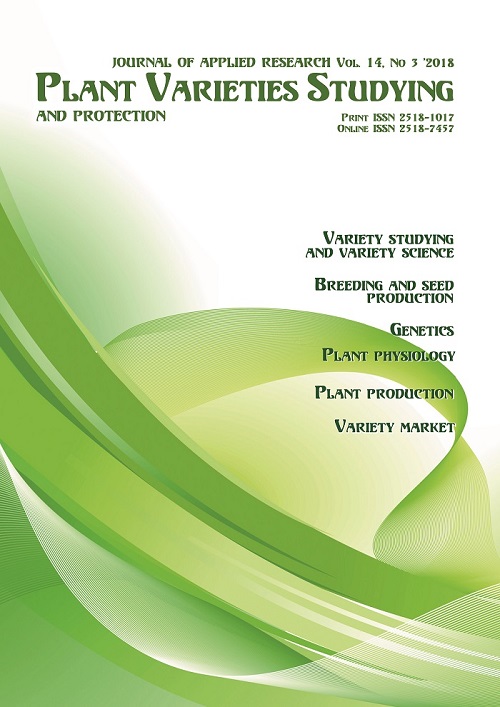Growth and productivity of some cultivars of energy willow, depending on the degree of soil moisture
DOI:
https://doi.org/10.21498/2518-1017.14.3.2018.145310Keywords:
energy plantation, Salix viminalis L., Salix triandra L., Salix dasyclados Wimm., soil moisture, plant height, productivity of raw above the ground massAbstract
Purpose. To determine the optimal soil moisture conditions for intensive growth and high productivity of energy plantations of some willow cultivars in the conditions of Kyiv Polissya.
Methods. The object of the study was the energy plantations of three willow cultivars: Salix viminalis L. cv. ‘Ternopilska’, S. triandra L. cv. ‘Yaroslava’ and S. dasyclados Wimm. cv. ‘Khors’. Plantations were created in 2009 in Boyarka forestry (Boyarka Forest Experimental Station). The soil is clayey-sandy. Plantations grew on three sites with different degrees of soil moisture: slightly-moisturized, well-moisturized and strongly-moisturized.
Results. After two years of cultivation, the highest ‘plant survival rate’ was peculiar for well-moisturized soil. It was 98.5% for ‘Ternopilska’, 97.1% for ‘Yaroslava’, and 89.6% for ‘Khors’ varieties. The highest average height of two years old plants was observed on a well-moistened soil – 3.2±0.06 m (‘Yaroslava’ variety). ‘Ternopilska’ variety on less-wetted soil had the highest height. The plants of ‘Khors’ variety had near-the-same height, regardless of the level of soil moisture. Study of these plantations in the age of eight years, when the age of their above-the-ground part was of 5 years old, showed that ‘Yaroslava’ cultivar significantly exceeds the productivity of ‘Ternopilska’ and ‘Khors’, when grow on slightly- (122.0 t/ha) and well-moisturized soils (128.2 t/ha of raw biomass). The productivity of ‘Ternopilska’ and ‘Khors’ cultivars significantly decrease with the soil moisture increasing. ‘Ternopilska’ plantations produce 46.4 t/ha of raw cut mass after 5-year cultivation on slightly-moisturized soil, and only 19.8 t/ha on strongly-moisturized soil. ‘Khors’ variety characterized by the higher level of productivity on different soil moistening (from 39.4 to 67.0 t/ha).
Conclusions. Among the three studied cultivars of willow the highest growth and productivity indexes on clayey-sandy soils of the Kyiv Polissya has ‘Yaroslava’ cultivar. Optimal conditions for intensive growth of ‘Yaroslava’ cultivar peculiar to energy plantation on well-moisturized soils and for ‘Ternopilska’, and ‘Khors’ – on slightly-moisturized and well-moisturized soils. Over-moisturized, poorly drained soils are of little use for the efficient cultivation of energy willow raw materials.
Downloads
References
Sinchenko, V. M. (Ed.). (2015). Enerhetychna verba: tekhnolohiia vyroshchuvannia ta vykorystannia [Energy willow: technology of cultivation and use]. Vinnytsia: Nilan-LTD. [in Ukrainian]
Fuchylo, Ya. D., & Sbytna, M. V. (2009). Verby Ukrainy (biolohiia, ekolohiia, vykorystannia) [Willows of Ukraine: biology, ecology, use]. Kyiv: Logos. [in Ukrainian]
Fuchylo, Ya. D., Hnap, I. V., & Hanzhenko, O. M. (2018). Growth and productivity of some foreign cultivars of energy willow in Volyn Opillia. Plant Varieties Studying and Protection, 14(2), 230–239. doi: 10.21498/2518-1017.14.2.2018.134775 [in Ukrainian]
El Bassam, N. (2010). Handbook of Bioenergy Crops. A Complete Reference to Species, Development and Applications. London; Washington, DC: Earthscan.
Fuchylo, Ya. D. (2011). Plantatsiine lisovyroshchuvannia: teoriia, praktyka, perspektyvy [Forest plantations: theory, practice, perspectives]. Kyiv: Lohos. [in Ukrainian]
Sinchenko, V. M. (Ed.). (2018). Metodolohiia doslidzhennia enerhetychnykh plantatsii verb i topol [Methodology for studying of energy plantations of willow and poplar]. Kyiv: Komprynt. [in Ukrainian]
Afonin, A. A., & Fuchylo, Ya. D. (2012). Genetic potential of bascket willow (Salix viminalis L.) of the middle stream of Desna river. Naukovyi visnyk NUBiP Ukrainy. Seriia: Lisivnytstvo ta dekoratyvne sadivnytstvo [Scientific Bulletin of NULES of Ukraine. Series: Arboriculture and Ornamental Horticulture], 171(1), 11–19. [in Ukrainian]
Caslin, B., Finnan, J., & McCracken, A. (Eds.). (2012). Willow Varietal Identification Guide. Carlow, Ireland: Teagasc & AFBI.
Gorelov A. M., Fuchylo, Ya. D., Krugliak Y. M., Viriovka, V. M., & Gorelov, A. A. (2014). Hybridization and selection of willows as a promising direction to obtain highly productive clones. Lisivnytstvo i agrolisomelioratsiya [Forestry & Forest Melioration], 125, 108–114. [in Ukrainian]
Afonin, A. A. (2005). Metodologicheskie printsipy sozdaniya ustoychivykh vysokoproduktivnykh nasazhdeniy iv (na primere avtokhtonnykh vidov Bryanskogo lesnogo massiva) [Methodological principles for the creation of steady highly productive plantations of willows (on the example of autochthonic species of Bryansk forest)]. Bryansk: RIO Bryanskogo gos. un-ta. [in Russian]
Yeshchenko, V. O., Kopytko, P. H., Opryshko, V. P., & Kostohryz, P. V. (2005). Osnovy naukovyh doslidzhen v agronomii [Basic research in agronomy]. Kyiv: Diia. [in Ukrainian]
Downloads
Published
How to Cite
Issue
Section
License
Copyright (c) 2018 Ukrainian Institute for Plant Variety Examination

This work is licensed under a Creative Commons Attribution-ShareAlike 4.0 International License.
Starting in 2022, the copyright to the publication remains with the authors
Our journal abides by the CREATIVE COMMONS copyright rights and permissions for open access journals.
Authors, who are published in this journal, agree to the following conditions:
- The authors reserve the right to authorship of the work and pass the first publication right of this work to the journal under the terms of a Creative Commons Attribution License, which allows others to freely distribute the published research with the obligatory reference to the authors of the original work and the first publication of the work in this journal.
- The authors have the right to conclude separate supplement agreements that relate to non-exclusive work distribution in the form in which it has been published by the journal (for example, to upload the work to the online storage of the journal or publish it as part of a monograph), provided that the reference to the first publication of the work in this journal is included.

























 Ukrainian Institute for Plant Varieties Examination
Ukrainian Institute for Plant Varieties Examination  Селекційно-генетичний інститут
Селекційно-генетичний інститут Institute of Plant Physiology and Genetics of the National Academy of Sciences of Ukraine
Institute of Plant Physiology and Genetics of the National Academy of Sciences of Ukraine
 The National Academy of Agrarian Sciences of Ukraine
The National Academy of Agrarian Sciences of Ukraine